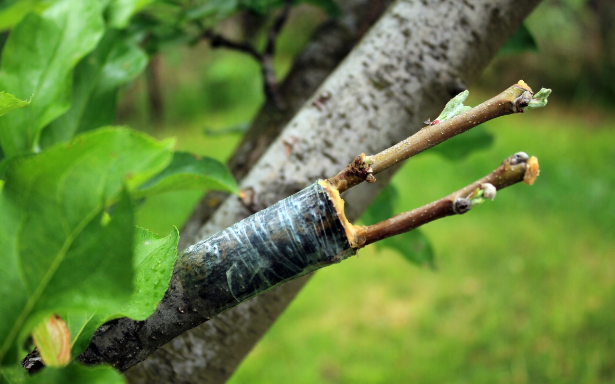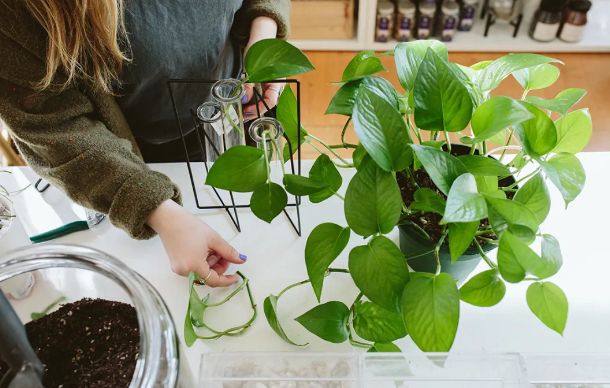Picture this–a beautiful pothos plant cascades from a hanging pot, but you wish you had more. You wonder, how can I grow more pothos when it has no seeds? Well, the answer is simple: vegetative propagation. Vegetative propagation is a form of asexual reproduction by which a portion of a plant is used to grow a completely separate copy of the original plant. It is a fascinating process with a multitude of different methods that work effectively and efficiently.
Cutting

Cutting is the typical go-to when it comes down to vegetative propagation. It is a simple process that does not require a great amount of time. When cutting, you want to consider some important information such as when the plant can be cut. While some methods can only be performed during certain seasons, cutting focuses on the plant itself and its own requirements. You also want to consider where you can cut the plant. All plants contain nodes, which are ultimately indicators of where a plant’s leaf or bud is growing from on the stem. To begin the process, cut right below a node on the plant’s stem. Typically, the segment should have at least four nodes for successful vegetative propagation. Place your cuttings in a container with a moistened paper towel on top if you plan on cutting multiple. Afterward, cut off any extra foliage surrounding the bottom half of the cutting in order to prevent any dryness. Then, much like when the plant can be cut, the media it is placed into is also dependent on the type of plant. The majority of plant cuttings can directly be placed into water. However, I suggest researching your plant in case it thrives better in soil.
Division

While it may not be as popular as cutting, division is one of the easiest methods of propagation. The division is dependent on the season in which each perennial plant (a plant that continuously regrows over a span of multiple years) grows. It is best to divide a few months earlier in each plant’s individual growing season. You can start the process of division by removing the entirety of the plant from its growing media; this means you must remove its roots as well. After doing so, split the plant into however many portions you’d like using whatever gardening tool works best for you (e.g. a knife, rake, shovel). Make sure you are separating each portion’s roots from the rest. Finally, you can place your portion in new soil and watch it grow as its own individual plant!
Grafting

Grafting is on the harder, less popular side of these methods. However, it is one of the methods that makes vegetative propagation so interesting. The goal of grafting is to replace the root of a plant that has a poor root system by combining (typically) two plants. Scion is the upper portion (that roots poorly) of the grafted plant and rootstock is the bottom portion, whose roots are stronger and more reliable. When it comes down to time, it is preferred that you graft when scion and rootstock are dormant. There are two ways you can graft: through the “Whip and Tongue” method and the “Chip Budding” method. To begin the “Whip and Tongue” method, you take a knife and create cuts within the scion and rootstock. You then interlock the two of them through these cuts and wrap/tie them together. They will eventually fuse together after a period of time. To begin the “Chip Budding” method, instead of cutting the scion, you take a fresh bud off of the wood. Afterward, you create an indentation in the rootstock that allows the bud to fit. Lastly, you wrap the bud and the rootstock together, and within a few months, your plants will have fused. Keep in mind that grafting is usually done by professional nursery operators.
Layering

Layering is a less-known method of propagation yet one of the easiest. To achieve this method, all you need is a plant in the soil and something that can weigh a plant down. You start off by taking one stem of a plant and holding it down using a small rock or a fabric pin. When you do so, make sure the stem that is being weighed down is touching the soil completely. For plants with harder stems, I suggest scraping the stem lightly on the point at which the stem will bend. Maintain normal care of the plant for the next few months and see how the bent stem has formed its own roots. Although, the plant should have a small tie with the root of the mother plant as well. If it is evident that the plant has formed its own root system, cut the root that connects the mother plant to the new plant and remove the item weighing the new plant down.
Vegetative propagation is one of my favorite aspects of at-home gardening and botany in general. The ability we have to simply replicate and modify a plant in only a few steps is truly unfathomable. With propagation, you can combine and separate millions of different plants and adjust different characteristics to your liking. I highly recommend looking into steps online with added visuals and videos if this topic interests you.












